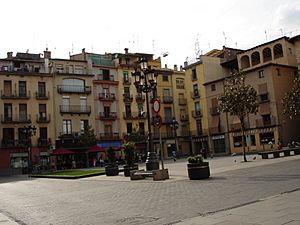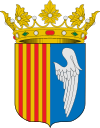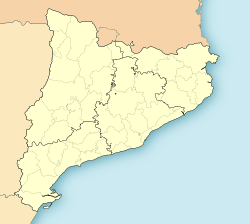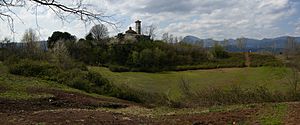Olot facts for kids
Quick facts for kids
Olot
|
|||
|---|---|---|---|
|
Municipality
|
|||

The Plaça Major of Olot
|
|||
|
|||
| Nickname(s):
La ciutat dels volcans
(The city of the volcanoes) |
|||
| Country | Spain | ||
| Community | Catalonia | ||
| Province | Girona | ||
| Comarca | Garrotxa | ||
| Area | |||
| • Total | 29.0 km2 (11.2 sq mi) | ||
| Elevation | 443 m (1,453 ft) | ||
| Population
(2018)
|
|||
| • Total | 34,486 | ||
| • Density | 1,189.2/km2 (3,080/sq mi) | ||
| Climate | Cfb | ||
Olot (Catalan: [uˈlɔt]; Spanish: [oˈlot]) is a city in Catalonia, Spain. It is the main city of the Garrotxa area. Olot is famous for its amazing natural beauty. It has four volcanoes right in the city! The whole area is part of the Zona Volcànica de la Garrotxa Natural Park.
Olot is also known for its art and culture. It has a rich history of art movements, like the Olot school. Many factories here make religious images. This led to the main Design and Arts & Crafts school of the Province of Girona being located here. It is called the Escola d'Art i Superior de Disseny d'Olot.
From 1911 to 1969, a narrow-gauge train line connected Olot to Girona. This old railway line is now a greenway, which is a path for walking and cycling.
Contents
What's in a Name?
The exact meaning of the name Olot is not fully clear. There are a few ideas about where it came from.
One old story says that a king named Ulo founded the city. He supposedly named it Ulot. Another popular idea is that the name comes from the Catalan word ala, which means "wing". This is because old documents sometimes called the city Aulot or Alot. Because of this, the city's coat of arms (its official symbol) has a wing on it.
Exploring Olot's Geography
Olot covers an area of about 29 square kilometers. This includes the city of Olot itself and the nearby town of Batet de la Serra. Batet de la Serra joined Olot in 1971. The city is about 443 meters above sea level. It is also about 50 kilometers away from Girona, which is the capital of the province.
Olot is surrounded by mountains like Valentí and Aiguanegra. The Fluvià river and the Riudaura stream flow through the flat land where the city sits.
Volcanoes and Rivers
There are four volcanoes right inside the city of Olot. They are called Montolivet, Montsacopa, Garrinada, and Bisaroques.
The Fluvià river flows into the Mediterranean Sea. It carries about 1.07 cubic meters of water per second.
Olot's Climate
The Garrotxa area, where Olot is located, usually gets more rain than nearby regions. The city receives about 1000 millimeters of rain each year. People in Catalonia often say, "If it isn't raining in Olot, it isn't raining anywhere." This shows how much rain the city gets!
In January, the coldest month, temperatures in Olot are around 0°C. In August, the warmest month, temperatures can reach about 28°C.
How Many People Live Here?
Olot has grown quite a bit over the years. Here's a look at how its population has changed:
| Population census | ||||||||||||||||||||||||||||||||||||||||||||||||||||||||||||||||||||||||||||||||||||||||||||||||||||||||||||||||||||||
|---|---|---|---|---|---|---|---|---|---|---|---|---|---|---|---|---|---|---|---|---|---|---|---|---|---|---|---|---|---|---|---|---|---|---|---|---|---|---|---|---|---|---|---|---|---|---|---|---|---|---|---|---|---|---|---|---|---|---|---|---|---|---|---|---|---|---|---|---|---|---|---|---|---|---|---|---|---|---|---|---|---|---|---|---|---|---|---|---|---|---|---|---|---|---|---|---|---|---|---|---|---|---|---|---|---|---|---|---|---|---|---|---|---|---|---|---|---|---|
|
|
|
|
|
||||||||||||||||||||||||||||||||||||||||||||||||||||||||||||||||||||||||||||||||||||||||||||||||||||||||||||||||||
| Source: IDESCAT | ||||||||||||||||||||||||||||||||||||||||||||||||||||||||||||||||||||||||||||||||||||||||||||||||||||||||||||||||||||||
Top Places to See
The Montsacopa volcano is one of the most important symbols of Olot. It has a round crater and offers a 360-degree view of the city from its top. There's also a small chapel dedicated to Saint Francis and two old watchtowers near the crater.
Historic Buildings
Olot's old town dates back to the 9th century. It has many interesting old buildings:
- The Hospici (a charity building) has a beautiful three-story neo-classical cloister.
- The church of la Mare de Déu del Tura is dedicated to Olot's patron saint.
- The El Carme cloister is from the Renaissance period and is a very important cultural site.
- The Sant Esteve Parish Church was built in 1763. It holds valuable art, including a painting by El Greco called Christ carrying the Cross.
- You can also see examples of Art Nouveau architecture, like the Solà-Morales house.
Art and Museums
Olot has a strong tradition in painting, sculpture, and ceramics. It's also famous for its Nativity Scenes (pessebres) and sculptures of saints. The School of Art, founded in 1783, is now the most important art school in the province of Girona. You can see the city's artistic heritage in its museums, especially the Museu Comarcal de la Garrotxa.
Natural Wonders
Olot is home to two important natural areas: Moixina and Parc Nou. These areas have special oak woods with rare plants. These woods have inspired many painters from the "Olot school".
Since the city is in the Zona Volcànica de la Garrotxa Natural Park, there are many other amazing natural spots nearby. These include the Fageda d'en Jordà, which is a unique beech forest with volcanic bumps, and the natural springs of Sant Roc.
The city also has a bicycle lane that connects to Girona. This path used to be an old railway line.
Delicious Food
Olot has its own special foods! Some popular local products are:
- Ratafia: a sweet herbal liquor.
- Coca de llardons and tortell de matafaluga: traditional cakes.
- Local charcuterie (cured meats).
- Olot potatoes: potato wafers filled with meat, covered in egg and flour, then deep-fried.
- Dishes made with buckwheat flour.
Some restaurants in Olot work together to offer what they call "volcanic cuisine." This means they create dishes inspired by the local volcanic landscape and ingredients.
Famous People from Olot
- Miquel Blay
- Antonio Soler
- Marià Vayreda
- Pedro Llosas Badía
- Maria Branyas, who was once the oldest living person in the world.
Sister Cities
Olot has special connections with two cities in France:
Images for kids
See also
 In Spanish: Olot para niños
In Spanish: Olot para niños









